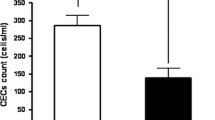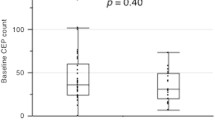Abstract
Background
Proof of concept studies has reported that circulating endothelial cell (CEC) count may be associated with the outcome of HER2-negative metastatic breast cancer (mBC) patients treated by chemotherapy and the anti-VEGF antibody bevacizumab. We report the results obtained in an independent prospective validation cohort (COMET study, NCT01745757).
Methods
The main baseline criteria were HER2-negative mBC, performance status 0–2 and no prior chemotherapy for metastatic disease. CECs were detected by CellSearch® from 4 ml of blood at baseline and after 4 weeks of weekly paclitaxel and bevacizumab therapy. CEC counts (considered both as a continuous variable and using the previously described 20 CEC/4 ml cutoff) were associated with clinical characteristics and progression-free survival (PFS).
Results
CEC count was obtained in 251 patients at baseline and in 207 patients at 4 weeks. Median baseline CEC count was 22 CEC/4 ml (range 0–2231). Baseline CEC counts were associated with performance status (p = 0.02). No statistically significant change in CEC counts was observed between baseline and 4 weeks of therapy. High baseline CEC count was associated with shorter PFS in univariate and multivariate analyses (continuous: p < 0.001; dichotomized: HR 1.52, 95% CI [1.15–2.02], p = 0.004). CEC counts at 4 weeks had no prognostic impact.
Conclusion
This study confirms that CEC count may be associated with the outcome of mBC patients treated with chemotherapy and bevacizumab. However, discrepancies with previous reports in terms of both the timing of CEC count and the direction of the prognostic impact warrant further clinical investigation.




Similar content being viewed by others
References
Shaked Y, Henke E, Roodhart JML et al (2008) Rapid chemotherapy-induced acute endothelial progenitor cell mobilization: implications for antiangiogenic drugs as chemosensitizing agents. Cancer Cell 14:263–273. https://doi.org/10.1016/j.ccr.2008.08.001
Miller K, Wang M, Gralow J et al (2007) Paclitaxel plus bevacizumab versus paclitaxel alone for metastatic breast cancer. N Engl J Med 357:2666–2676. https://doi.org/10.1056/NEJMoa072113
Miles DW, Chan A, Dirix LY et al (2010) Phase III study of bevacizumab plus docetaxel compared with placebo plus docetaxel for the first-line treatment of human epidermal growth factor receptor 2-negative metastatic breast cancer. J Clin Oncol 28:3239–3247. https://doi.org/10.1200/JCO.2008.21.6457
Robert NJ, Diéras V, Glaspy J et al (2011) RIBBON-1: randomized, double-blind, placebo-controlled, phase III trial of chemotherapy with or without bevacizumab for first-line treatment of human epidermal growth factor receptor 2-negative, locally recurrent or metastatic breast cancer. J Clin Oncol 29:1252–1260. https://doi.org/10.1200/JCO.2010.28.0982
Miles DW, Diéras V, Cortés J et al (2013) First-line bevacizumab in combination with chemotherapy for HER2-negative metastatic breast cancer: pooled and subgroup analyses of data from 2447 patients. Ann Oncol 24:2773–2780. https://doi.org/10.1093/annonc/mdt276
Mancuso P, Burlini A, Pruneri G et al (2001) Resting and activated endothelial cells are increased in the peripheral blood of cancer patients. Blood 97:3658–3661
Calleri A, Bono A, Bagnardi V et al (2009) Predictive potential of angiogenic growth factors and circulating endothelial cells in breast cancer patients receiving metronomic chemotherapy plus bevacizumab. Clin Cancer Res 15:7652–7657. https://doi.org/10.1158/1078-0432.CCR-09-1493
Riethdorf S, Fritsche H, Müller V et al (2007) Detection of circulating tumor cells in peripheral blood of patients with metastatic breast cancer: a validation study of the Cell Search system. Clin Cancer Res 13:920–928. https://doi.org/10.1158/1078-0432.CCR-06-1695
Simkens LHJ, Tol J, Terstappen LWMM et al (2010) The predictive and prognostic value of circulating endothelial cells in advanced colorectal cancer patients receiving first-line chemotherapy and bevacizumab. Ann Oncol 21:2447–2448. https://doi.org/10.1093/annonc/mdq640
Ikeda S, Kato T, Ogura T et al (2018) Phase II study of bevacizumab, cisplatin, and docetaxel plus maintenance bevacizumab as first-line treatment for patients with advanced non-squamous non-small-cell lung cancer combined with exploratory analysis of circulating endothelial cells: thoracic Oncology Research Group (TORG)1016. BMC Cancer 18:241. https://doi.org/10.1186/s12885-018-4150-y
Bidard F-C, Mathiot C, Degeorges A et al (2010) Clinical value of circulating endothelial cells and circulating tumor cells in metastatic breast cancer patients treated first line with bevacizumab and chemotherapy. Ann Oncol 21:1765–1771. https://doi.org/10.1093/annonc/mdq052
Pierga J-Y, Petit T, Delozier T et al (2012) Neoadjuvant bevacizumab, trastuzumab, and chemotherapy for primary inflammatory HER2-positive breast cancer (BEVERLY-2): an open-label, single-arm phase 2 study. Lancet Oncol 13:375–384. https://doi.org/10.1016/S1470-2045(12)70049-9
McShane LM, Altman DG, Sauerbrei W et al (2005) Reporting recommendations for tumor marker prognostic studies (REMARK). J Natl Cancer Inst 97:1180–1184. https://doi.org/10.1093/jnci/dji237
Rowand JL, Martin G, Doyle GV et al (2007) Endothelial cells in peripheral blood of healthy subjects and patients with metastatic carcinomas. Cytometry A 71:105–113. https://doi.org/10.1002/cyto.a.20364
Bidard F-C, Kiavue N, Ychou M et al (2019) Circulating tumor cells and circulating tumor dna detection in potentially resectable metastatic colorectal cancer: a Prospective Ancillary Study to the Unicancer Prodige-14 Trial. Cells. https://doi.org/10.3390/cells8060516
Bidard F-C, Michiels S, Riethdorf S et al (2018) Circulating tumor cells in breast cancer patients treated by neoadjuvant chemotherapy: a meta-analysis. J Natl Cancer Inst 110:560–567. https://doi.org/10.1093/jnci/djy018
Bidard F-C, Peeters DJ, Fehm T et al (2014) Clinical validity of circulating tumour cells in patients with metastatic breast cancer: a pooled analysis of individual patient data. Lancet Oncol 15:406–414. https://doi.org/10.1016/S1470-2045(14)70069-5
Khan SS, Solomon MA, McCoy JP (2005) Detection of circulating endothelial cells and endothelial progenitor cells by flow cytometry. Cytometry B Clin Cytom 64:1–8. https://doi.org/10.1002/cyto.b.20040
Strijbos MH, Gratama JW, Kraan J et al (2008) Circulating endothelial cells in oncology: pitfalls and promises. Br J Cancer 98:1731–1735. https://doi.org/10.1038/sj.bjc.6604383
Smirnov DA, Foulk BW, Doyle GV et al (2006) Global gene expression profiling of circulating endothelial cells in patients with metastatic carcinomas. Cancer Res 66:2918–2922. https://doi.org/10.1158/0008-5472.CAN-05-4003
Goon PKY, Boos CJ, Stonelake PS et al (2006) Detection and quantification of mature circulating endothelial cells using flow cytometry and immunomagnetic beads: a methodological comparison. Thromb Haemost 96:45–52. https://doi.org/10.1160/TH06-04-0185
Almici C, Neva A, Skert C et al (2019) Counting circulating endothelial cells in allo-HSCT: an ad hoc designed polychromatic flowcytometry-based panel versus the cell search system. Sci Rep 9:87. https://doi.org/10.1038/s41598-018-36442-9
Kraan J, Strijbos MH, Sieuwerts AM et al (2012) A new approach for rapid and reliable enumeration of circulating endothelial cells in patients. J Thromb Haemost 10:931–939. https://doi.org/10.1111/j.1538-7836.2012.04681.x
Manzoni M, Comolli G, Torchio M et al (2015) Circulating endothelial cells and their subpopulations: role as predictive biomarkers in antiangiogenic therapy for colorectal cancer. Clin Colorectal Cancer 14:11–17. https://doi.org/10.1016/j.clcc.2014.12.002
Ali AM, Ueno T, Tanaka S et al (2011) Determining circulating endothelial cells using cell search system during preoperative systemic chemotherapy in breast cancer patients. Eur J Cancer 47:2265–2272. https://doi.org/10.1016/j.ejca.2011.06.015
Najjar F, Alammar M, Bachour M, Al-Massarani G (2014) Circulating endothelial cells as a biomarker in non-small cell lung cancer patients: correlation with clinical outcome. Int J Biol Markers 29:e337–344. https://doi.org/10.5301/jbm.5000100
Yuan D, Zhang Q, Lv Y et al (2015) Predictive and prognostic significance of circulating endothelial cells in advanced non-small cell lung cancer patients. Tumour Biol 36:9031–9037. https://doi.org/10.1007/s13277-015-3657-y
Malka D, Boige V, Jacques N et al (2012) Clinical value of circulating endothelial cell levels in metastatic colorectal cancer patients treated with first-line chemotherapy and bevacizumab. Ann Oncol 23:919–927. https://doi.org/10.1093/annonc/mdr365
Bertucci F, Fekih M, Autret A et al (2016) Bevacizumab plus neoadjuvant chemotherapy in patients with HER2-negative inflammatory breast cancer (BEVERLY-1): a multicentre, single-arm, phase 2 study. Lancet Oncol 17:600–611. https://doi.org/10.1016/S1470-2045(16)00011-5
Pierga J-Y, Bidard F-C, Autret A et al (2017) Circulating tumour cells and pathological complete response: independent prognostic factors in inflammatory breast cancer in a pooled analysis of two multicentre phase II trials (BEVERLY-1 and -2) of neoadjuvant chemotherapy combined with bevacizumab. Ann Oncol 28:103–109. https://doi.org/10.1093/annonc/mdw535
Bocci G, Di Paolo A, Danesi R (2013) The pharmacological bases of the antiangiogenic activity of paclitaxel. Angiogenesis 16:481–492. https://doi.org/10.1007/s10456-013-9334-0
Kerbel RS, Kamen BA (2004) The anti-angiogenic basis of metronomic chemotherapy. Nat Rev Cancer 4:423–436. https://doi.org/10.1038/nrc1369
Matsusaka S, Suenaga M, Mishima Y et al (2011) Circulating endothelial cells predict for response to bevacizumab-based chemotherapy in metastatic colorectal cancer. Cancer Chemother Pharmacol 68:763–768. https://doi.org/10.1007/s00280-010-1543-2
Acknowledgement
We are grateful to patients who participated in the study. This research was funded by Roche. UNICANCER is the sponsor of the study.
Author information
Authors and Affiliations
Corresponding author
Ethics declarations
Conflict of interest
JY Pierga received lecture honoraria, travel grant and research funding from Roche; FC Bidard received travel grant and research funding from Roche, Menarini Silicon Biosystems; A Goncalves received travel, accommodation and meeting registration support from Pfizer, Novartis, Roche, AstraZeneca, MSD, Celgene; O Tredan received honoraria from Roche, Novartis, AstraZeneca, Pfizer, Lilly and MSD for boards and symposiums. Other authors have stated explicitly that they have no conflicts of interest in connection with this article.
Additional information
Publisher's Note
Springer Nature remains neutral with regard to jurisdictional claims in published maps and institutional affiliations.
Rights and permissions
About this article
Cite this article
Vasseur, A., Cabel, L., Tredan, O. et al. Prognostic value of CEC count in HER2-negative metastatic breast cancer patients treated with bevacizumab and chemotherapy: a prospective validation study (UCBG COMET). Angiogenesis 23, 193–202 (2020). https://doi.org/10.1007/s10456-019-09697-7
Received:
Accepted:
Published:
Issue Date:
DOI: https://doi.org/10.1007/s10456-019-09697-7




